Luminescence and Gamma Spectroscopy of Phosphate Glass Doped with Nd3+/Yb3+ and Their Multifunctional Applications
Abstract
:1. Introduction
2. Materials and Methods
3. Results and Discussion
Absorption Spectroscopy, Optical Energy Gap and Judd–Ofelt Analysis
| Host | Transition | Wavelength (nm) | A (s−1) | Τ (ms) | Β (%) |
|---|---|---|---|---|---|
| PZLBNdYb [PW] | 4F3/2→4I9/2 | 882 | 253.24 | 1.644 | 41 |
| 4F3/2→4I11/2 | 1051 | 294.29 | 48 | ||
| P2O5-Li2O3-GdF3-Nd2O3 [29] | 4F3/2→4I9/2 | 874 | 2917 | 0.151 | 44 |
| 4F3/2→4I11/2 | 1065 | 3091 | 47 | ||
| PZLNNd1.0 [38] | 4F3/2→4I9/2 | 873 | 398 | 41 | |
| 4F3/2→4I11/2 | 1052 | 342 | 53 | ||
| 3000 ppm Nd3+/Yb3+ in phosphate glasses [14] | 4F3/2→4I9/2 | 896 | 403.8 | 0.77 | 31 |
| 4F3/2→4I11/2 | 1056 | 716.2 | 55 | ||
| 30,000 ppm Nd3+/Yb3+ in phosphate glasses [13] | 4F3/2→4I9/2 | 896 | 280.2 | 0.13 | 36 |
| 4F3/2→4I11/2 | 1056 | 395.1 | 51 |
4. Conclusions
Author Contributions
Funding
Institutional Review Board Statement
Informed Consent Statement
Data Availability Statement
Acknowledgments
Conflicts of Interest
References
- Dorosz, D.; Żmojda, J.; Kochanowicz, M.; Dorosz, J. Nd3+/Yb3+ Doped Phosphate and Antimony Glasses for Optical Fibre Source. Acta Phys. Pol. A 2010, 118, 1108. [Google Scholar] [CrossRef]
- Afef, B.; Alqahtani, M.M.; Hegazy, H.H.; Yousef, E.; Damak, K.; Maâlej, R. Green and near-infrared emission of Er3+ doped PZS and PZC glasses. J. Lumin. 2018, 194, 706–712. [Google Scholar] [CrossRef]
- Lachheb, R.; Damak, K.; Assadi, A.A.; Herrmann, A.; Yousef, E.; Rüssel, C.; Maâlej, R. Characterization of Tm3+ doped TNZL glass laser material. J. Lumin. 2015, 161, 281–287. [Google Scholar] [CrossRef]
- Damak, K.; Yousef, E.; AlFaify, S.; Rüssel, C.; Maâlej, R. Raman, green and infrared emission cross-sections of Er3+ doped TZPPN tellurite glass. Opt. Mater. Express 2014, 4, 597–612. [Google Scholar] [CrossRef]
- Deguil, N.; Mottay, E.; Salin, F.; Legros, P.; Choquet, D. Novel diode-pumped infrared tunable laser system for multi-photon microscopy. Microsc. Res. Technol. 2004, 63, 23. [Google Scholar] [CrossRef]
- Singh, V.P.; Badiger, N.M.; Kaewkhao, J. Radiation shielding competence of silicate and borate heavy metal oxide glasses: Comparative study. J. Non-Cryst. Solids 2014, 404, 167–173. [Google Scholar] [CrossRef]
- Singh, K.; Singh, S.; Dhaliwal, A.S.; Singh, G. Gamma radiation shielding analysis of lead-flyash concretes. Appl. Radiat. Isot. 2015, 95, 174–179. [Google Scholar] [CrossRef]
- Tijani, S.A.; Kamal, S.M.; Al-Hadeethi, Y.; Arib, M.; Hussein, M.A.; Wageh, S.; Dim, L.A. Radiation shielding properties of transparent erbium zinc tellurite glass system determined at medical diagnostic energies. J. Alloy. Compd. 2018, 741, 293–299. [Google Scholar] [CrossRef]
- Qi, F.; Huang, F.; Wang, T.; Ye, R.; Lei, R.; Tian, Y.; Zhang, J.; Zhang, L.; Xu, S. Highly Er3+ doped fluorotellurite glass for 1.5 µm broadband amplification and 2.7 µm microchip laser applications. J. Lumin. 2018, 202, 132–135. [Google Scholar] [CrossRef]
- Hussein, K.I.; Alqahtani, M.S.; Alzahrani, K.J.; Alqahtani, F.F.; Zahran, H.Y.; Alshehri, A.M.; Yahia, I.S.; Reben, M.; Yousef, E.S. The Effect of ZnO, MgO, TiO2, and Na2O Modifiers on the Physical, Optical, and Radiation Shielding Properties of a TeTaNb Glass System. Materials 2022, 15, 1844. [Google Scholar] [CrossRef]
- Lalla, E.A.; Konstantinidis, M.; De Souza, I.; Daly, M.G.; Martín, I.R.; Lavín, V.; Rodríguez-Mendoza, U.R. Judd-Ofelt parameters of RE3+-doped fluorotellurite glass (RE3+ = Pr3+, Nd3+, Sm3+, Tb3+, Dy3+, Ho3+, Er3+, and Tm3+). J. Alloys Compd. 2020, 845, 156028. [Google Scholar] [CrossRef]
- Judd, B.R. Optical absorption intensities of rare-earth ions. Phys. Rev. 1962, 127, 750–761. [Google Scholar] [CrossRef]
- Ofelt, G.S. Intensities of crystal spectra of rare−earth ions. J. Chem. Phys. 1962, 37, 511–520. [Google Scholar] [CrossRef]
- Zaman, F.; Srisittipokakun, N.; Rooh, G.; Khattak, S.A.; Singkiburin, N.; Kim, H.J.; Sangwaranatee, N.; Kaewkhao, J. Investigation of Li2O–Gd2O3–MO–B2O3–Nd2O3 (MO=Ba/Bi) glasses for laser applications by Judd–Oflet (J–O) theory. J. Lumin. 2019, 215, 116639. [Google Scholar] [CrossRef]
- Afef, B.; Hegazy, H.H.; Algarni, H.; Yang, Y.; Damak, K.; Yousef, E.; Maâlej, R. Spectroscopic analysis of trivalent Nd3+/Yb3+ ions codoped in PZS host glasses as a new laser material at 1.06 μm. J. Rare Earths 2017, 35, 361–367. [Google Scholar] [CrossRef]
- James, J.T.; Jose, J.K.; Manjunatha, M.; Suresh, K.; Madhu, A. Structural, luminescence and NMR studies on Nd3+-doped sodium–calcium-borate glasses for lasing applications. Ceram. Int. 2020, 46, 27099–27109. [Google Scholar] [CrossRef]
- Yusof, N.N.; Ghoshal, S.K.; Jupri, S.A. Luminescence of Neodymium Ion-Activated Magnesium Zinc Sulfophosphate Glass: Role of Titanium Nanoparticles Sensitization. Opt. Mater. 2020, 109, 110390. [Google Scholar] [CrossRef]
- Siva Rama Krishna Reddy, K.; Swapna, K.; Mahamuda, S.; Venkateswarulu, M.; Rao, A.S. Structural, optical and photoluminescence properties of alkaline-earth boro tellurite glasses doped with trivalent Neodymium for 1.06 μm optoelectronic devices. Opt. Mater. 2021, 111, 110615. [Google Scholar] [CrossRef]
- Elbashar, Y.H.; Rayan, D.A. Judd Ofelt Study of Absorption Spectrum for Neodymium Doped Borate Glass. Int. J. Appl. Chem. 2016, 12, 59–66. [Google Scholar]
- De Sa, G.F.; Malta, O.L.; de Mello Donegá, C.; Simas, A.M.; Longo, R.L.; Santa-Cruz, P.A.; da Silva, E.F., Jr. Spectroscopic properties and design of highly luminescent lanthanide coordination complexes. Coord. Chem. Rev. 2000, 196, 165–195. [Google Scholar] [CrossRef]
- Carnall, W.T.; Hessler, J.P.; Wagner, F., Jr. Transition probabilities in the absorption and fluorescence spectra of lanthanides in molten lithium nitrate-potassium nitrate eutectic. J. Phys. Chem. 1978, 82, 2152. [Google Scholar] [CrossRef]
- Singh, G.; Tiwari, V.S.; Gupta, P.K. Spectroscopic analysis on the basis Judd–Ofelt theory of Nd3+ in (Y0.985Nd0.015)2O3: A transparent laser-host ceramic. Mater. Res. Bull. 2014, 60, 838–842. [Google Scholar] [CrossRef]
- Kaminskii, A.A. Laser Crystals: Their Physics and Properties; Springer: Berlin, Germany, 1981; pp. 157–158. [Google Scholar]
- Krupke, W.F. Induced-emission cross sections in neodymium laser glasses. IEEE J. Quant. Electron. 1971, 7, 153. [Google Scholar] [CrossRef]
- Campbell, J.H.; Suratwala, T.I.; Suratwala, T.I. Continuous melting of phosphate laser glasses. J. Non-Cryst. Solids 2000, 263–264, 342–357. [Google Scholar] [CrossRef]
- Jayasankar, C.K.; Balakrishnaiah, R.; Venkatramu, V.; Joshi, A.S.; Speghini, A.; Bettinelli, M. Luminescence characteristics of Nd3+ -doped K-Ba-Al-fluorophosphate laser glasses. J. Alloy Comp. 2008, 451, 697–701. [Google Scholar] [CrossRef]
- Gupta, G.; Sontakke, A.D.; Karmakar, P.; Biswas, K.; Balaji, S.; Saha, R.; Sen, R.; Annapurna, K. Influence of bismuth on structural, elastic and spectroscopic properties of Nd3+ doped zinc–boro-bismuthate glasses. J. Lumin. 2014, 149, 163–169. [Google Scholar] [CrossRef]
- Binnemans, K.; Van Deun, R.; Gorller-Walrand, C.; Adam, J.L. Spectroscopic properties of trivalent lanthanide ions in fuorophosphate glasses. J. Non-Cryst. Solids 1998, 238, 11–29. [Google Scholar] [CrossRef]
- Shoaib, M.; Rooh, G.; Chanthima, N.; Kim, H.J.; Kaewkhao, J. Luminescence properties of Nd3+ ions doped P2O5-Li2O3-GdF3 glasses for laser applications. Opt.-Int. J. Light Electron. Opt. 2019, 199, 163218. [Google Scholar] [CrossRef]
- Prasad, V.R.; Dhamodaraiah, S.; Babu, S.; Ratnakaram, Y.C. Spectroscopic investigation of Nd3+ doped zinc phosphate glasses for NIR emission at 1.05 μ-m. Mater Today Proc. 2016, 3, 3805–3809. [Google Scholar] [CrossRef]
- Jorgensen, C.K.; Reisfeld, R. Judd-Ofelt parameters and chemical bonding. J. Common Met. 1983, 93, 107–112. [Google Scholar] [CrossRef]
- Reisfeld, R. Luminescence and prediction of transition probabilities for solar energy and lasers. J. Common. Met. 1985, 112, 9–18. [Google Scholar] [CrossRef]
- Jacobs, R.; Weber, M. Dependence of the 4F3/2→4I11/2 induced-emission cross section for Nd3+ on glass composition. IEEE J. Quant. Electron. 1976, 12, 102–111. [Google Scholar] [CrossRef]
- Riseberg, L.A.; Weber, M.J. Relaxation phenomena in rare-earth luminescence. Prog. Opt. 1977, 31, 89–159. [Google Scholar]
- Fares, H.; Jlassi, I.; Hraiech, S.; Elhouichet, H.; Ferid, M. Radiative parameters of Nd3+-doped titanium and tungsten modified tellurite glasses for 1.06 μm laser materials. J. Quant. Spectrosc. Radiat. Transf. 2014, 147, 224–232. [Google Scholar] [CrossRef]
- Manasa, P.; Srihari, T.; Basavapoornima, C.; Joshi, A.S.; Jayasankara, C.K. Spectroscopic investigations of Nd3+ ions in niobium phosphate glasses for laser applications. J. Lumin. 2019, 211, 233–242. [Google Scholar] [CrossRef]
- Prasad, R.N.A.; Praveena, R.; Vijaya, N.; Babu, P.; Krishna Mohan, N. Neodymiumdoped magnesium phosphate glasses for NIR laser applications at 1.05 μm. Mater. Res. Express 2019, 6, 096204. [Google Scholar]
- Ramteke, D.D.; Kroon, R.E.; Swart, H.C. Infrared emission spectroscopy and upconversion of ZnO-Li2O-Na2O-P2O5 glasses doped with Nd3+ ions. J. Non-Cryst. Solids 2017, 457, 157–163. [Google Scholar] [CrossRef]
- Chanthima, N.; Kaewkhao, J. Investigation of radiation shielding parameters of bismuth borosilicate glass from 1 keV to 100 GeV. Ann. Nucl. Energy 2013, 55, 23–28. [Google Scholar] [CrossRef]
- Chanthima, N.; Kaewkhao, J.; Limkitjaroenporn, P.; Tuscharoen, S.; Kothan, S.; Tungjai, M.; Kaewjaeng, S.; Sarachai, S.; Limsuwan, P. Development of BaO–ZnO–B2O3 glasses as a radiation shielding material. Radiat. Phys. Chem. 2017, 137, 72–77. [Google Scholar] [CrossRef]
- Cheewasukhanont, W.; Limkitjaroenporn, P.; Sayyed, M.I.; Kothan, S.; Kim, H.J.; Kaewkhao, J. High density of tungsten gadolinium borate glasses for radiation shielding material: Effect of WO3 concentration. Radiat. Phys. Chem. 2022, 192, 109926. [Google Scholar] [CrossRef]
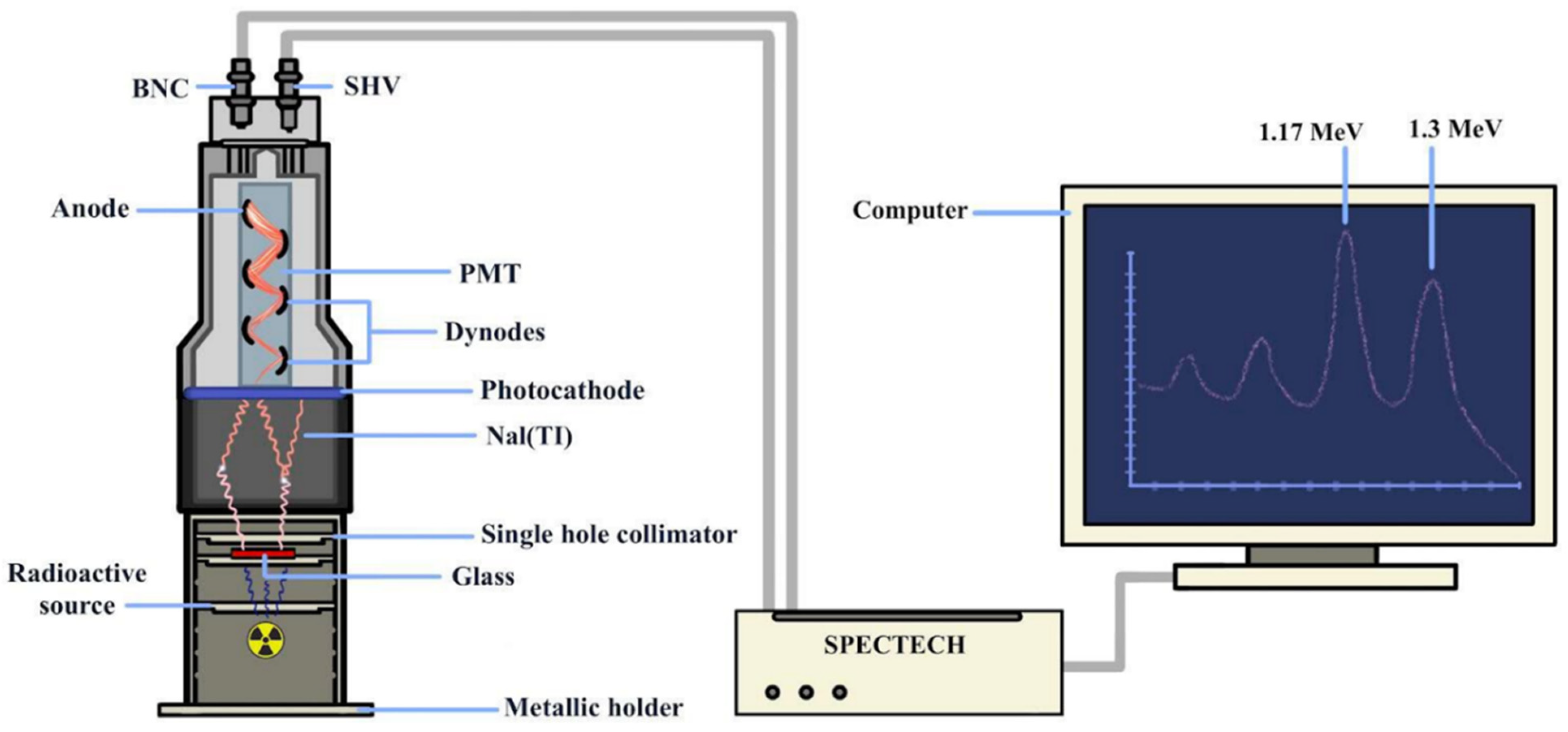
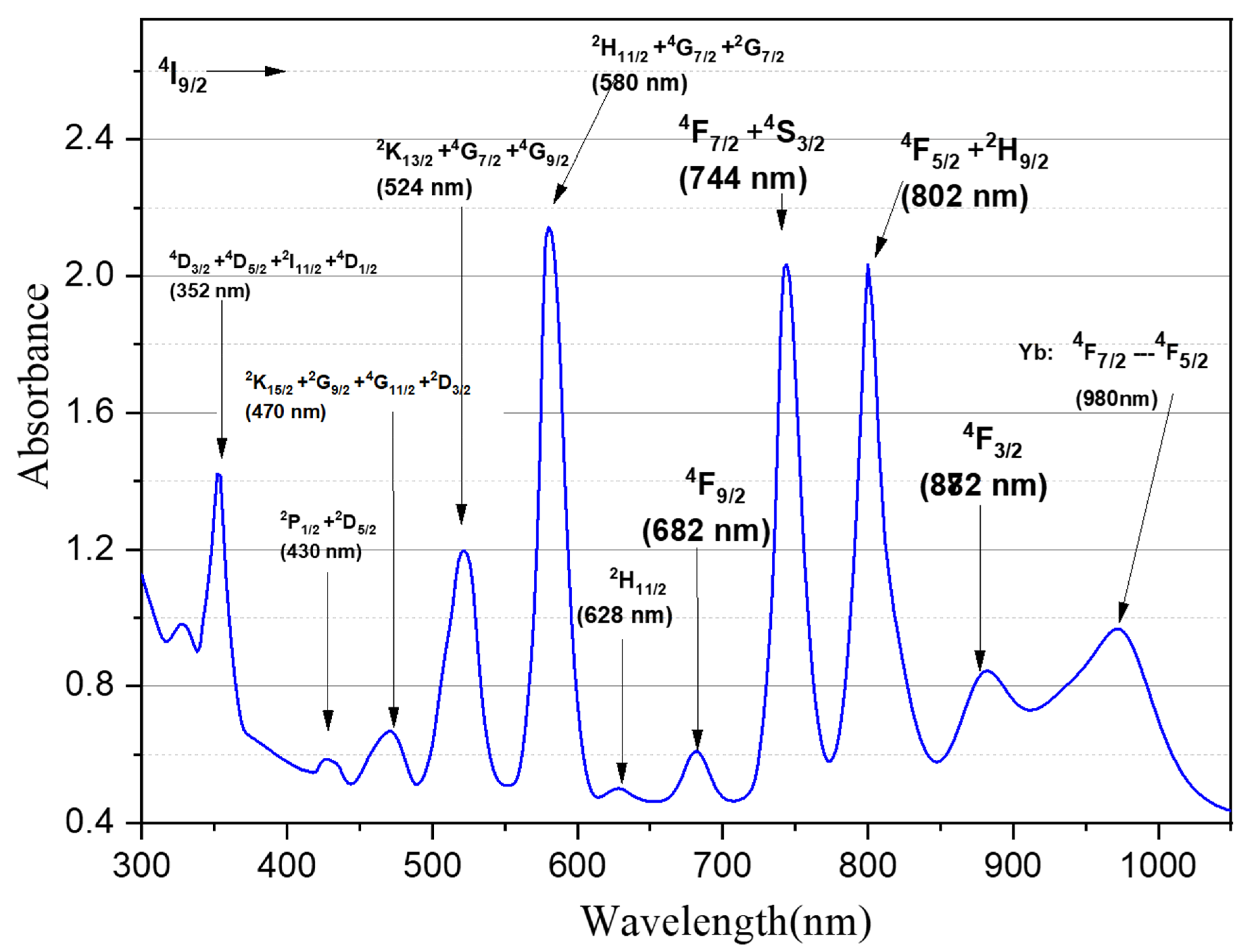
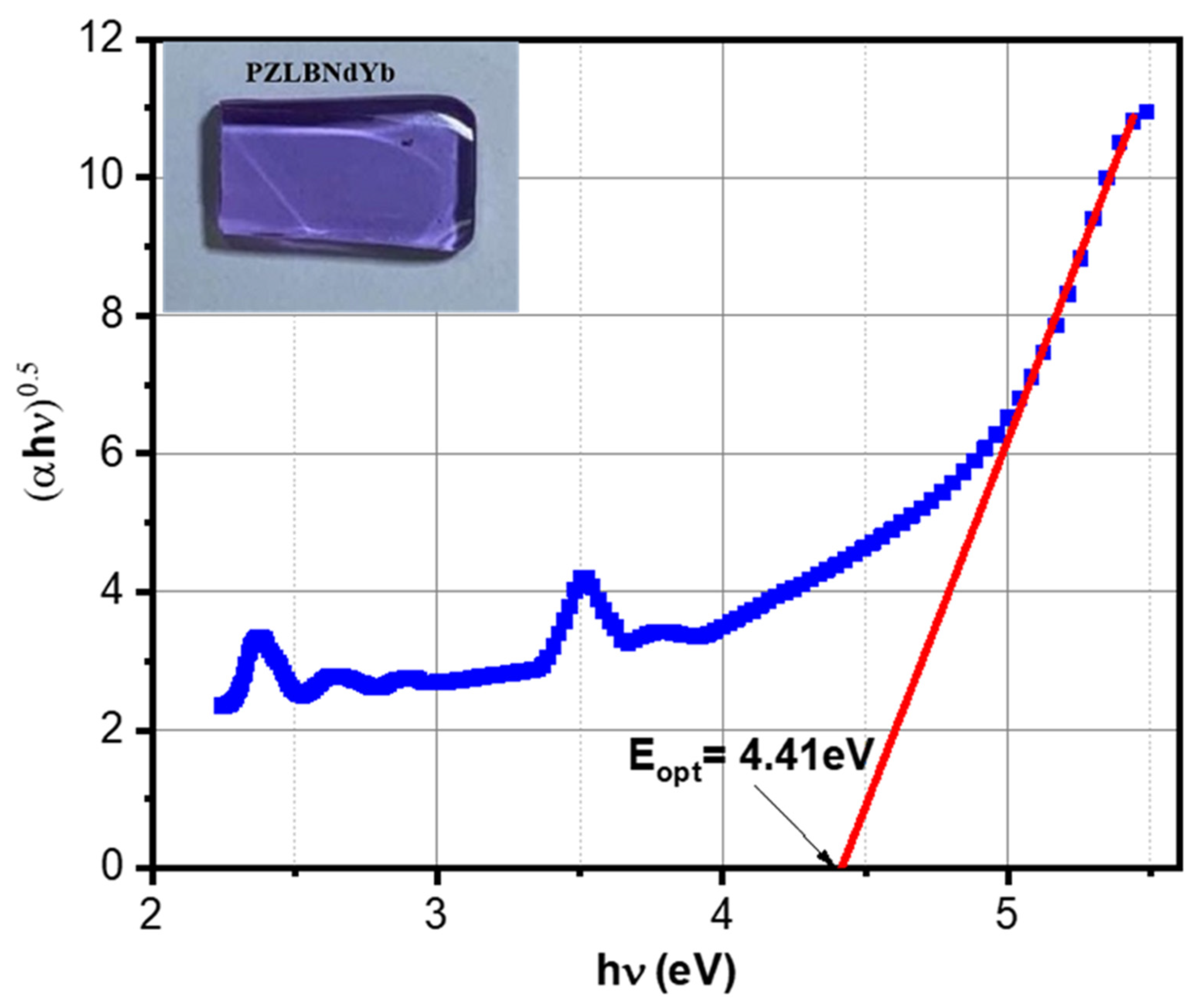
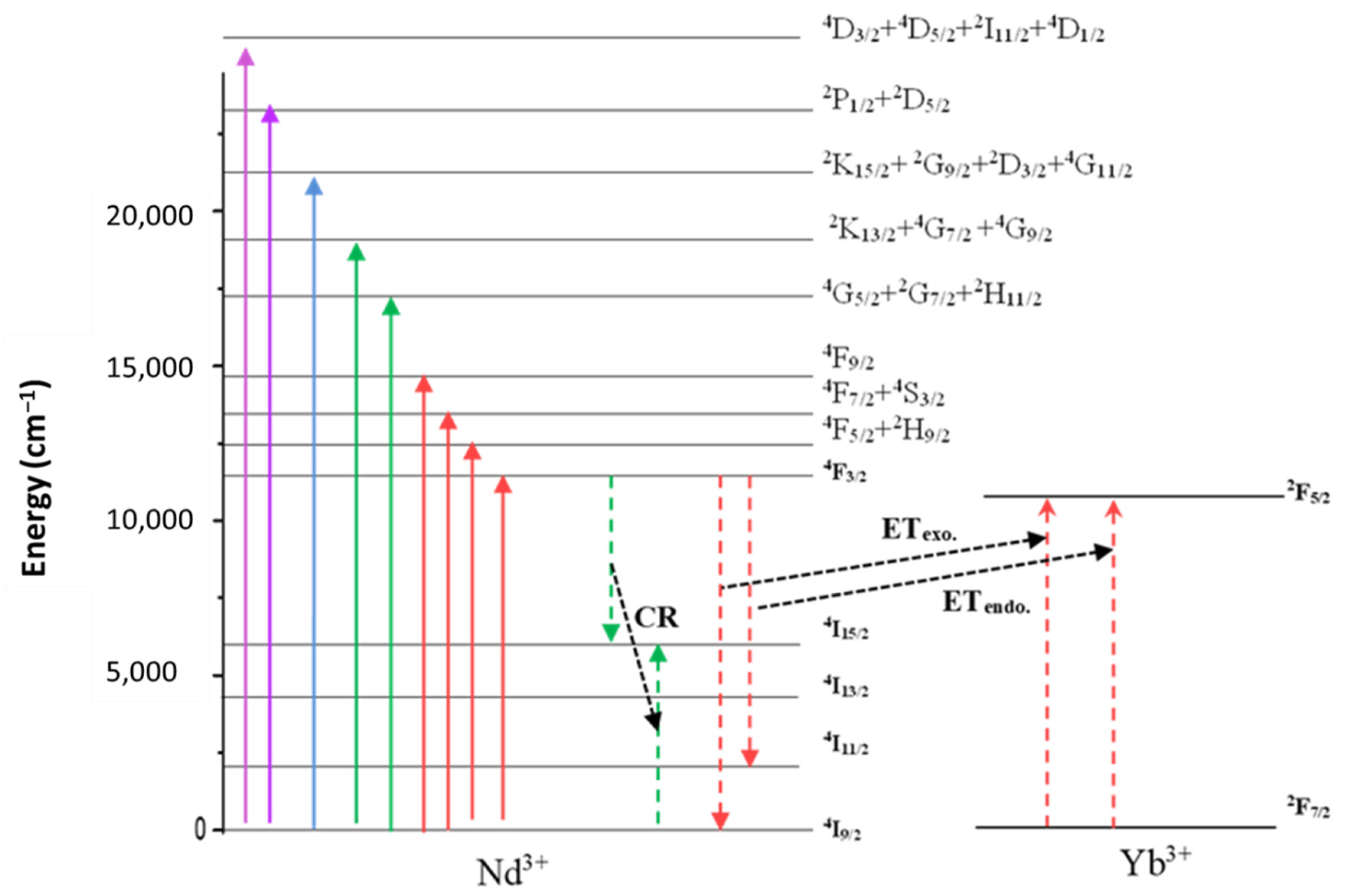
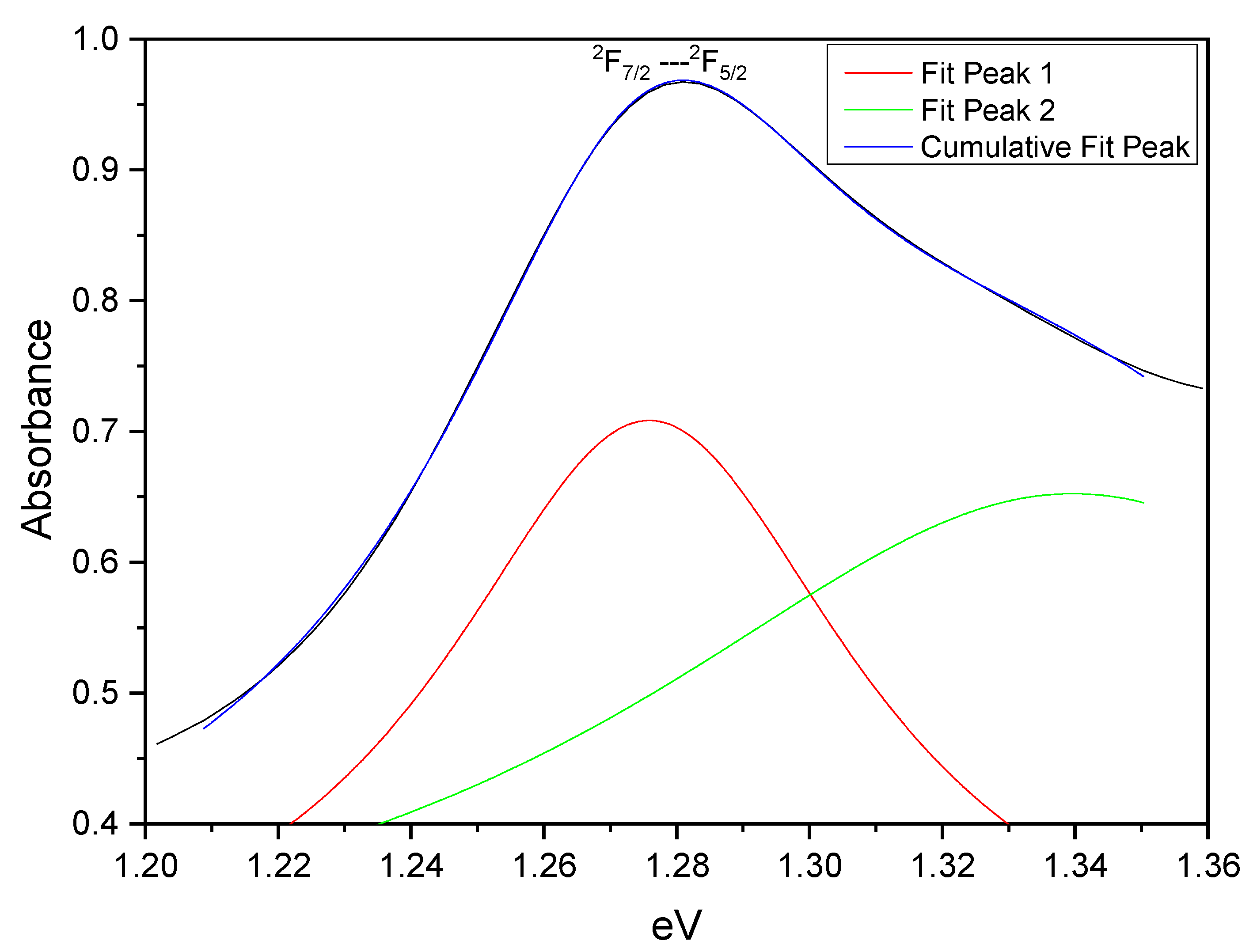
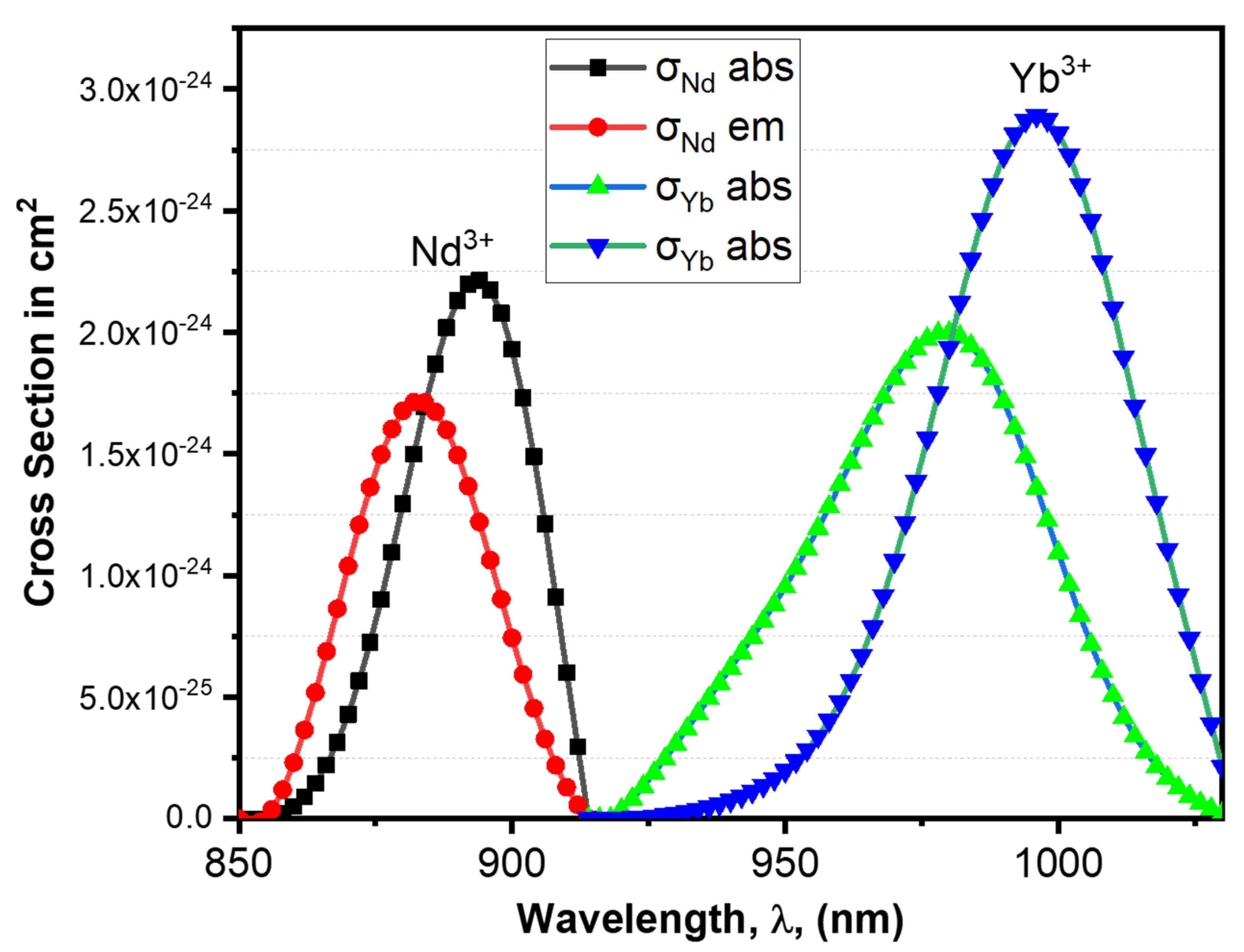
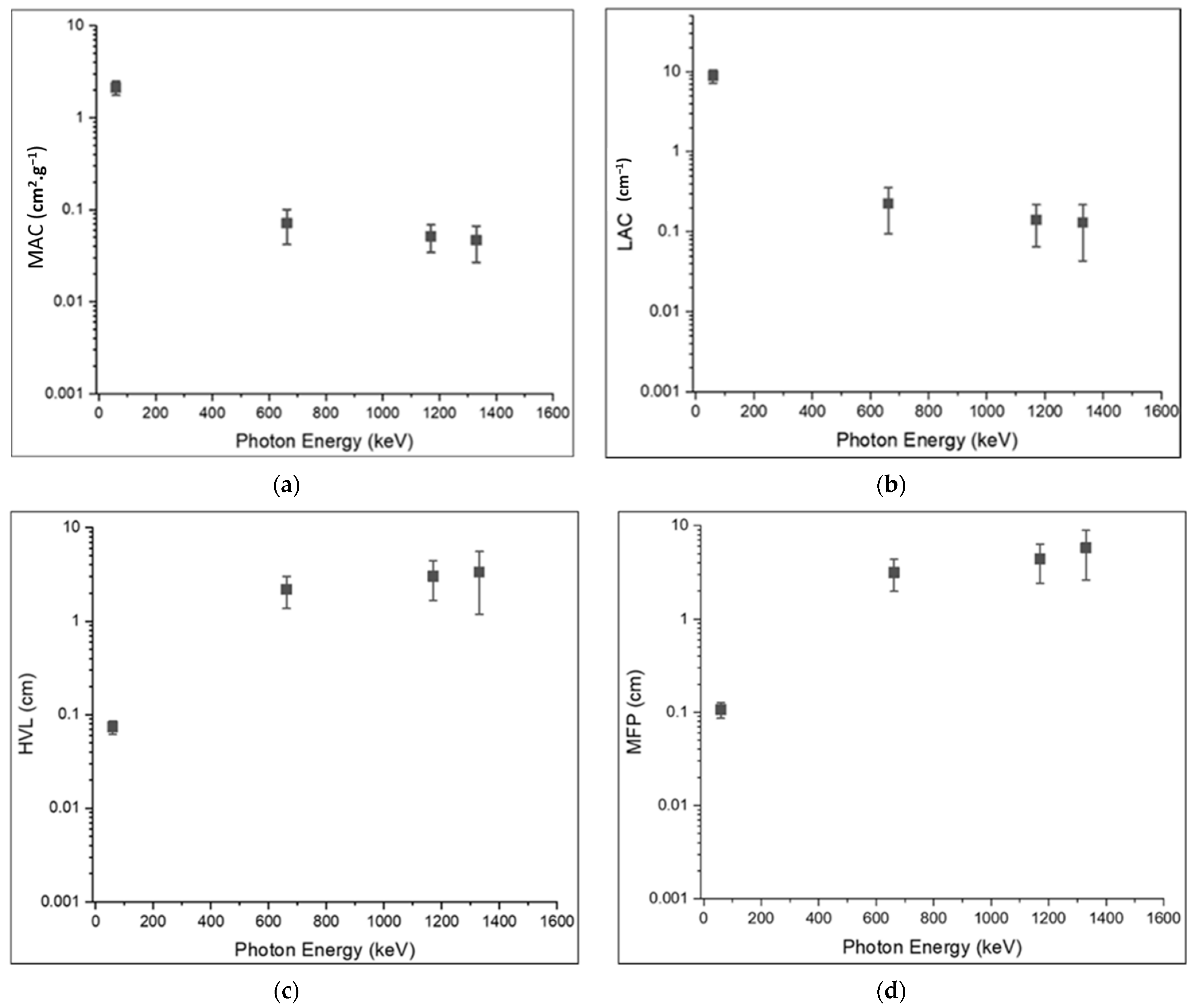
| Transitions: 4I9/2→ | λ (nm) | ν (cm−1) | ||U2||2 | ||U4||2 | ||U6||2 | Γ (nm·cm−1) | Sexp (10−26 m2) | Scal (10−26 m2) |
|---|---|---|---|---|---|---|---|---|
| 4D3/2 + 4D5/2 + 2I11/2 + 4D1/2 | 352 | 28,409 | 0.0050 | 0.5256 | 0.0478 | 7.8511 | 24.489 | 22.244 |
| 2P1/2 + 2D5/2 | 430 | 23,255 | 0.0000 | 0.0369 | 0.0021 | 0.5117 | 1.2993 | 1.4960 |
| 2K15/2 + 2G9/2 + 2D3/2 + 4G11/2 | 470 | 21,276 | 0.0010 | 0.0472 | 0.0364 | 3.1505 | 7.3169 | 3.4488 |
| 2K13/2 + 4G7/2 +4G9/2 | 524 | 19,083 | 0.0665 | 0.2182 | 0.1271 | 16.22 | 34.053 | 15.772 |
| 4G5/2 + 2G7/2 + 2H11/2 | 580 | 17,241 | 0.9737 | 0.5968 | 0.0777 | 27.298 | 51.294 | 52.438 |
| 4F9/2 | 682 | 14,662 | 0.0009 | 0.0092 | 0.0417 | 2.6065 | 4.1785 | 2.2393 |
| 4F7/2 + 4S3/2 | 744 | 13,440 | 0.0010 | 0.045 | 0.6598 | 25.624 | 37.600 | 31.252 |
| 4F5/2 + 2H9/2 | 802 | 12,468 | 0.0102 | 0.2451 | 0.5127 | 14.853 | 20.269 | 32.523 |
| 4F3/2 | 882 | 11,467 | 0.0000 | 0.2293 | 0.0548 | 2.0965 | 2.6098 | 11.164 |
| Systems | Ω2 | Ω4 | Ω6 | Trend | χ |
|---|---|---|---|---|---|
| PZLBNdYb [Present Work]: | 0.269 | 0.379 | 0.447 | Ω2 < Ω4 < Ω6 | 0.84 |
| LGBaBNd05 [12] | 6.10 | 6.85 | 9.83 | Ω2 < Ω4 < Ω6 | 0.69 |
| YAG:Nd3+ [24] | 0.20 | 2.70 | 5.00 | Ω2 < Ω4 < Ω6 | 0.54 |
| LHG-750 [25] | 4.60 | 4.80 | 5.60 | Ω2 < Ω4 < Ω6 | 0.85 |
| PKFBAN10 [26] | 4.92 | 3.67 | 5.26 | Ω4 < Ω2 < Ω6 | 0.70 |
| ZnBBi [27] | 3.56 | 4.30 | 4.87 | Ω2 < Ω4 < Ω6 | 0.88 |
| Nd3+:fluorotellurite(n = cst) [11] | 4.21 | 5.97 | 5.45 | Ω2 < Ω6 < Ω4 | 1.09 |
| Nd3+:fluorotellurite(n ≠ cst) [11] | 4.51 | 6.34 | 6.16 | Ω2 < Ω6 < Ω4 | 1.02 |
| Nd3+ doped Y2O3 ceramic [22] | 8.84 | 9.82 | 4.44 | Ω6 < Ω2 < Ω4 | 2.21 |
| 75NaPO3-24CaF2-1NdF3 [28] | 2.78 | 4.16 | 5.56 | Ω2 < Ω4 < Ω6 | 0.74 |
| 3000 ppm Nd3+/Yb3+ in phosphate [13] | 1.897 | 0.820 | 1.834 | Ω4 < Ω6 < Ω2 | 0.44 |
| 30,000 ppm Nd3+/Yb3+ in phosphate [13] | 0.2339 | 0.6437 | 0.9598 | Ω2 < Ω4 < Ω6 | 0.67 |
| NCB:Nd glasses [14] | 1.50 | 0.93 | 2.39 | Ω4 < Ω2 < Ω6 | 0.39 |
| PMZ1.5 Nd [15] | 4.69 | 4.72 | 2.98 | Ω6 < Ω2 < Ω4 | 1.58 |
| AEBTNd0.1 [16] | 3.694 | 2.865 | 2.548 | Ω2 < Ω4 < Ω6 | 1.12 |
| P2O5-Li2O3-GdF3-Nd2O3 [29] | 8.55 | 11.54 | 10.25 | Ω2 < Ω6 < Ω4 | 1.13 |
| Nd3+ doped zinc phosphate [30] | 4.67 | 5.53 | 5.77 | Ω2 < Ω4 < Ω6 | 0.95 |
| Transition | Energy (cm−1) | A (s−1) | Τ (ms) | Β (%) |
|---|---|---|---|---|
| 4F3/2→4I9/2 | 882 | 253.24 | 1.644 | 41.639 |
| 4F3/2→4I11/2 | 1051 | 294.29 | 48.389 | |
| 4F3/2→4I13/2 | 1329 | 57.675 | 9.4834 | |
| 4F3/2→4I15/2 | 1827 | 2.9709 | 0.4884 | |
| 4I15/2→4I9/2 | 1626 | 1.6995 | 118.78 | 20.187 |
| 4I15/2→4I11/2 | 2478 | 4.5382 | 53.905 | |
| 4I15/2→4I13/2 | 4878 | 2.1812 | 25.909 | |
| 4I13/2→4I9/2 | 2440 | 5.935 | 126.42 | 75.028 |
| 4I13/2→4I11/2 | 5040 | 1.9754 | 24.972 | |
| 4I11/2→4I9/2 | 4730 | 2.5817 | 387.34 | 100 |
Publisher’s Note: MDPI stays neutral with regard to jurisdictional claims in published maps and institutional affiliations. |
© 2022 by the authors. Licensee MDPI, Basel, Switzerland. This article is an open access article distributed under the terms and conditions of the Creative Commons Attribution (CC BY) license (https://creativecommons.org/licenses/by/4.0/).
Share and Cite
Charfi, B.; Damak, K.; Alqahtani, M.S.; Hussein, K.I.; Alshehri, A.M.; Elkhoshkhany, N.; Assiri, A.L.; Alshehri, K.F.; Reben, M.; Yousef, E.S. Luminescence and Gamma Spectroscopy of Phosphate Glass Doped with Nd3+/Yb3+ and Their Multifunctional Applications. Photonics 2022, 9, 406. https://doi.org/10.3390/photonics9060406
Charfi B, Damak K, Alqahtani MS, Hussein KI, Alshehri AM, Elkhoshkhany N, Assiri AL, Alshehri KF, Reben M, Yousef ES. Luminescence and Gamma Spectroscopy of Phosphate Glass Doped with Nd3+/Yb3+ and Their Multifunctional Applications. Photonics. 2022; 9(6):406. https://doi.org/10.3390/photonics9060406
Chicago/Turabian StyleCharfi, Bilel, Kamel Damak, Mohammed S. Alqahtani, Khalid I. Hussein, Ali M. Alshehri, Nehal Elkhoshkhany, Abdullah L. Assiri, Khaled F. Alshehri, Manuela Reben, and El Sayed Yousef. 2022. "Luminescence and Gamma Spectroscopy of Phosphate Glass Doped with Nd3+/Yb3+ and Their Multifunctional Applications" Photonics 9, no. 6: 406. https://doi.org/10.3390/photonics9060406
APA StyleCharfi, B., Damak, K., Alqahtani, M. S., Hussein, K. I., Alshehri, A. M., Elkhoshkhany, N., Assiri, A. L., Alshehri, K. F., Reben, M., & Yousef, E. S. (2022). Luminescence and Gamma Spectroscopy of Phosphate Glass Doped with Nd3+/Yb3+ and Their Multifunctional Applications. Photonics, 9(6), 406. https://doi.org/10.3390/photonics9060406









